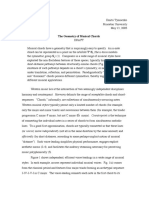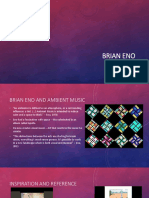When A String of An Instrument Is Played
When A String of An Instrument Is Played
Uploaded by
Karl WilsonCopyright:
Available Formats
When A String of An Instrument Is Played
When A String of An Instrument Is Played
Uploaded by
Karl WilsonOriginal Description:
Original Title
Copyright
Available Formats
Share this document
Did you find this document useful?
Is this content inappropriate?
Copyright:
Available Formats
When A String of An Instrument Is Played
When A String of An Instrument Is Played
Uploaded by
Karl WilsonCopyright:
Available Formats
JosephAn TheDivergentInfiniteSeries:TheHarmonicSeries The Harmonic Series is a concept that was first publicly introduced intothescientificworld by Nicole Oresme.
Oresme, however,isaccreditedwiththemaingloryofrevealingtheexistenceof the harmonic series, but ratherwereJohannBernoulliandJacobBernouilli,whorevampedthetopic intothescientificcommunitythreecenturieslaterinthe1600s. The harmonic serieswashistoricallyusedforarchitecturalpurposesprimarilyintheBaroque period to establish harmonic relationships between the exterior and interior features of floor plans and of elevations (Hersey). In music, the first term, or the fundamental wavelength (Pierce), is considered to produce the pitch the human ear perceives when a note is played by an instrument. However, when a harmoniccapable instrument produces a note, a harmonic series is produced, with smaller partial waves being emitted as well (Pierce). Although the note itself is perceived as the first term ofthe harmonicseries,thewholeharmonicseriesproducedbytheinstrumentcreatesa timbre, or quality of sound unique to an instrument (professional musicians can distinguish between different instruments when the same note is being played by multiple instruments. This is a result of their attuning to the harmonic effects produced by the individual instruments and ultimately, the timbreofeachsound).Timbreisalsoreferredtoasthetoneofthesound(Thompson).
The first term, the fundamental wavelength whenastringofaninstrumentisplayed.
(The fundamental wavelength, and the overtones/harmonics produced when a stringis played)
Examples of instances when harmonic sounds are producedbow pulling on a string, strummingaguitar. Examples of instances when inharmonic sounds are producedplucking a string, piano hammerstrikingapianostring. (Note that the terminharmonicityreferstotheoccurrenceofwhenatoneisproduced,the
partials produced do not strictly adhere to the rules of the harmonic series which are explained below). Aprincipleexampleofadiverginginfiniteseriesdenotedby:
, this summation represents the sum of fractions of constant integer multiplesofoneanother.Asthe terms increase, the numerical value of each termislessthanthetermsprecedingit(a3islessthana2 ora1).Graphically,theseriesisrepresentedbyalogarithmiccurvethatisexponentiallydecreasing.
(Graph by Jim Belk, an assistant professor of mathematics at Bard College)
Note that many students misinterpret the harmonic series as a sequence of terms, not as a summation of terms. For example, students misinterpret as the limit of 1/n as it approaches infinityessentially a sequence. Although the infinite sequence of 1/nconvergesto0, the infinite series of 1/n diverges to infinity. Although we cannot measure if the harmonic series reaches infinity (infinity being an abstract concept), we can accurately hypothesize it does so. One relativelysimplemethodtoevaluatetheharmonicseriesisbyuseofoneofOresmespostulates. OresmesPostulate(pregrouping)
=1/1+1/2+1/3+1/4+1/5+1/6+1/7+1/8+...+...= Oresme postulated that since the summation of 1/1 + 1/2 + 1/2 + 1/2 + 1/2 + 1/2 + . . . + ... equalsinfinity.,andthatgroupingtheharmonicseriesbythe2,4,8,16,terms(excludingthefirst two terms), results in each group being greater than 1/2 the harmonic series must diverge to infinity.Thegroupingisillustratedbelow.
OresmesPostulate(postgrouping)
=1/1+1/2+(1/3+1/4)+(1/5+1/6+1/7+1/8)+...+...=(line1) =1/1+1/2+(7/12)+(533/840)+...+...=(line2) If line 2 was extended, it wouldbeevidentthateachgroupingthatisdeviatedfromline1is greater than 1/2. Therefore, since 1/1 + 1/2+1/2+1/2+1/2+1/2+...+...=,line2must alsobetrue,andtheharmonicseriesdivergestoinfinity.
WorksCited Hersey,GeorgeL.,ArchitectureandGeometryintheAgeoftheBaroque,p1112and p3751.
Pierce, John R. (2001). "Consonance and Scales". In Perry R. Cook. Music, Cognition, and Computerized Sound. MIT Press. ISBN 978-0-262-53190-0. http://books.google.com/books?id=L04W8ADtpQ4C&pg=PA169&dq=musical+t one+harmonic+partial+fundamental+integer.
Thompson,WilliamForde(2008).Music,Thought,andFeeling:Understandingthe PsychologyofMusic.p.46.ISBN9780195377071. http://www.oup.com/us/catalog/general/subject/Psychology/CognitivePsychology/?view=usa&ci=97 80195377071.
You might also like
- Bartok Kodaly WorkshopDocument158 pagesBartok Kodaly WorkshopAdriano Nogueira100% (2)
- BQ3123Document19 pagesBQ3123Alexander Wernhart100% (1)
- Chopin - Voice Leading and Chromatic Harmony in The Music of ChopinDocument27 pagesChopin - Voice Leading and Chromatic Harmony in The Music of ChopinXiongguan ZhangNo ratings yet
- Partimento and Continuo Playing - Thomas Christensen y Otros PDFDocument136 pagesPartimento and Continuo Playing - Thomas Christensen y Otros PDFJuan Jose Francione100% (1)
- 17 The Immediate Impact of Different Types of Television On Young Children's Executive FunctionDocument8 pages17 The Immediate Impact of Different Types of Television On Young Children's Executive FunctionClaudia Ulloa MoralesNo ratings yet
- Physics and Music: Essential Connections and Illuminating ExcursionsFrom EverandPhysics and Music: Essential Connections and Illuminating ExcursionsNo ratings yet
- CCFCS collection of musical instruments: Volume 2: Idiophones and membranophonesFrom EverandCCFCS collection of musical instruments: Volume 2: Idiophones and membranophonesNo ratings yet
- How to Play Suona, the Chinese Double-reed Horn: The Basic Skills: How to Play Suona, the Chinese Double-reed Horn, #1From EverandHow to Play Suona, the Chinese Double-reed Horn: The Basic Skills: How to Play Suona, the Chinese Double-reed Horn, #1No ratings yet
- The Oboe:: An Outline of Its History, Development, and ConstructionFrom EverandThe Oboe:: An Outline of Its History, Development, and ConstructionNo ratings yet
- Italian Harpsichord-Building in the 16th and 17th CenturiesFrom EverandItalian Harpsichord-Building in the 16th and 17th CenturiesNo ratings yet
- Bluesharp Songbook - 50 German Folk Songs: Bluesharp Songbooks, #2From EverandBluesharp Songbook - 50 German Folk Songs: Bluesharp Songbooks, #2No ratings yet
- Density Degree of Intervals and ChordsDocument16 pagesDensity Degree of Intervals and ChordsClaudio Maioli100% (2)
- Harmonic Dualism or Harmonic PolarityDocument9 pagesHarmonic Dualism or Harmonic Polaritygalihkrobi100% (1)
- Voice LeadingDocument46 pagesVoice Leadingvicher2020No ratings yet
- Dane Rudhyar - The Magic of ToneDocument13 pagesDane Rudhyar - The Magic of ToneManuel CoitoNo ratings yet
- The Dissonance Curve and AppletDocument13 pagesThe Dissonance Curve and Appletmajestyc367100% (1)
- Monochord MattersDocument24 pagesMonochord MattersLawrence DunnNo ratings yet
- Alina Abraham (Novac at The Time) Spiral - Poster-1Document1 pageAlina Abraham (Novac at The Time) Spiral - Poster-1Alina L. AbrahamNo ratings yet
- A Primer For Atonal Set TheoryDocument20 pagesA Primer For Atonal Set TheoryHenrique974895734960% (1)
- Information Content in Melodic and Non-Melodic Lines: Northwestern UniversityDocument4 pagesInformation Content in Melodic and Non-Melodic Lines: Northwestern UniversityFabian MossNo ratings yet
- Torsional Waves in A Bowed StringDocument14 pagesTorsional Waves in A Bowed Stringpsykosomatik100% (1)
- Alfredo Capurso - A New Model of Interpretation of Some Acoustic Phenomena. Circular Harmonic System - C.HA.S.Document26 pagesAlfredo Capurso - A New Model of Interpretation of Some Acoustic Phenomena. Circular Harmonic System - C.HA.S.22nd Century Music100% (1)
- SchenkerDocument17 pagesSchenkerMoriarti Magonegro0% (1)
- Georg Friedrich Haas 5 ThesesDocument6 pagesGeorg Friedrich Haas 5 ThesesLucia KaplowitzNo ratings yet
- Analyse Nach Heinrich SchenkerDocument16 pagesAnalyse Nach Heinrich SchenkerWilliam AntoniouNo ratings yet
- Voice Leading and Chromatic Harmony in The Music of Chopin PDFDocument27 pagesVoice Leading and Chromatic Harmony in The Music of Chopin PDFCamilo ReyesNo ratings yet
- Sobre Armonia FuncionalDocument50 pagesSobre Armonia Funcionalmipalosa100% (1)
- Kahrs MA ThesisDocument70 pagesKahrs MA ThesisJared RedmondNo ratings yet
- Punctus Contra PunkusDocument2 pagesPunctus Contra PunkusspitfordNo ratings yet
- Abstract: This Paper Considers Three Conceptions of Musical Distance (OrDocument15 pagesAbstract: This Paper Considers Three Conceptions of Musical Distance (OrBryan Pitkin100% (1)
- Gruber - Mersenne and Evolving Tonal TheoryDocument33 pagesGruber - Mersenne and Evolving Tonal TheorySovereign100% (1)
- Allen Forte On SchenkerDocument8 pagesAllen Forte On SchenkerdundunNo ratings yet
- Ferguson, S., & Parncutt, R. (2004 D) - Composing 'In The Flesh' - Perceptually-Informed Harmonic Syntax.Document6 pagesFerguson, S., & Parncutt, R. (2004 D) - Composing 'In The Flesh' - Perceptually-Informed Harmonic Syntax.goni56509100% (1)
- Abstract. "Harmony," Writes Saariaho, "Provides The Impetus For Movement, Whilst TimbreDocument13 pagesAbstract. "Harmony," Writes Saariaho, "Provides The Impetus For Movement, Whilst TimbreUlianov MarínNo ratings yet
- Guide to the Practical Study of HarmonyFrom EverandGuide to the Practical Study of HarmonyRating: 5 out of 5 stars5/5 (4)
- The Mathematics of Musical InstrumentsDocument11 pagesThe Mathematics of Musical InstrumentsadamrouNo ratings yet
- Lesson 16 ResonanceDocument6 pagesLesson 16 ResonancedudoocandrawNo ratings yet
- An Exploration of Timbre Analysis: The Game of Sound in Two Performances ofDocument29 pagesAn Exploration of Timbre Analysis: The Game of Sound in Two Performances ofstephenspencer13100% (1)
- Music and Mathematics: Time, Rhythm and MeterDocument8 pagesMusic and Mathematics: Time, Rhythm and MeterEleno Hernandez100% (1)
- Notes On The Nature of HarmonyDocument11 pagesNotes On The Nature of Harmonyx100% (1)
- Nose-Bleed Music TheoryDocument3 pagesNose-Bleed Music TheoryChris AndersonNo ratings yet
- Hugo Riemann - Harmony SimplifiedDocument216 pagesHugo Riemann - Harmony SimplifiedSrgio Kno100% (4)
- Christensen PartimentoDocument136 pagesChristensen PartimentoJaume Bordas100% (5)
- Harrison 2003Document49 pagesHarrison 200314789630q100% (1)
- Cohn, 1996Document33 pagesCohn, 1996Millie Olexa100% (1)
- Paths To The New MusicDocument12 pagesPaths To The New MusicRichard CookeNo ratings yet
- Harmonic Series (Music)Document8 pagesHarmonic Series (Music)Sam ChowNo ratings yet
- Clostridium Botulinum Presentation For BIOMI2600 Joseph AnDocument12 pagesClostridium Botulinum Presentation For BIOMI2600 Joseph AnKarl WilsonNo ratings yet
- Syllabus For ImmunologyDocument5 pagesSyllabus For ImmunologyKarl WilsonNo ratings yet
- Open House: Are You Interested in A MS, PHD, or MD-PHD in The Biomedical Sciences?Document1 pageOpen House: Are You Interested in A MS, PHD, or MD-PHD in The Biomedical Sciences?Karl WilsonNo ratings yet
- Interested in Joining A Lab? We Will Help Get You Started!: Wednesday, November 19 From 5-6pm, 202 Uris HallDocument1 pageInterested in Joining A Lab? We Will Help Get You Started!: Wednesday, November 19 From 5-6pm, 202 Uris HallKarl WilsonNo ratings yet
- Clockwork by Lim Jeong Hee Piano SheetDocument3 pagesClockwork by Lim Jeong Hee Piano SheetKarl WilsonNo ratings yet
- Phys 1112Document2 pagesPhys 1112Karl WilsonNo ratings yet
- Organic Chemistry I: The Unofficial Reaction SheetDocument11 pagesOrganic Chemistry I: The Unofficial Reaction SheetKarl WilsonNo ratings yet
- Loudon 01-Table of ContentsDocument25 pagesLoudon 01-Table of ContentsKarl Wilson0% (1)
- The Effect of The Decline in Autopsies Performed in The U.S Joseph AnDocument7 pagesThe Effect of The Decline in Autopsies Performed in The U.S Joseph AnKarl WilsonNo ratings yet
- Ap-4 ManualDocument2 pagesAp-4 ManualRoberto DiazNo ratings yet
- PDF WLP Pre-K1 Quarter 1Document20 pagesPDF WLP Pre-K1 Quarter 1199kamlani100% (1)
- Mambo Dance Group5Document12 pagesMambo Dance Group5BataNo ratings yet
- Country CalendarDocument1 pageCountry CalendarUncle MattNo ratings yet
- 【20170226】NB-IoT Commercialization Starts Sailing-V2.8Document79 pages【20170226】NB-IoT Commercialization Starts Sailing-V2.8Ejaz Ahmad100% (2)
- MW Network Design HU Lec.4Document71 pagesMW Network Design HU Lec.4Mustafa KamalNo ratings yet
- Beyond Interpretation - John RinkDocument5 pagesBeyond Interpretation - John RinkStefanos TheodoridisNo ratings yet
- Word Formation10ºDocument3 pagesWord Formation10ºFilipa PintoNo ratings yet
- OOSCDocument3 pagesOOSCSaiqa SiddiquiNo ratings yet
- Ener ConDocument7 pagesEner ConArgel Linard Francisco MabagaNo ratings yet
- Intermusic - Using Sound DiverDocument3 pagesIntermusic - Using Sound DivervioguitarNo ratings yet
- Akeelah and The BeeDocument3 pagesAkeelah and The BeeEga KusumaNo ratings yet
- Emblem of Freedom (Andrew Glover) 012-3248-00Document16 pagesEmblem of Freedom (Andrew Glover) 012-3248-00AlexanderNo ratings yet
- Jessica Edwards: AEA Stage ManagerDocument1 pageJessica Edwards: AEA Stage Managerapi-280442551No ratings yet
- Dan Shay Ft. Justin Bieber - 10.000 Hours by Kelvin String PDFDocument3 pagesDan Shay Ft. Justin Bieber - 10.000 Hours by Kelvin String PDFIanni zianNo ratings yet
- String Fusion 7 Nation Army For String OrchestraDocument10 pagesString Fusion 7 Nation Army For String OrchestraElton Soares CoelhoNo ratings yet
- JanaGanaManaIndiaAnthem 1Document3 pagesJanaGanaManaIndiaAnthem 1GauravNo ratings yet
- Feel Like A StrangerDocument1 pageFeel Like A StrangerMichael ChicoriaNo ratings yet
- Little Bit of Morse Code History From WikipDocument2 pagesLittle Bit of Morse Code History From Wikipglh00No ratings yet
- WP350 ManualDocument134 pagesWP350 ManualdavidmontoyalopezNo ratings yet
- Baseline Processing ReportDocument21 pagesBaseline Processing ReportneedmorebooksNo ratings yet
- I Am Standing in A Queue at The SupermarketDocument1 pageI Am Standing in A Queue at The SupermarketAbril TejedaNo ratings yet
- Brian EnoPDF Michael McKenna PDFDocument8 pagesBrian EnoPDF Michael McKenna PDFMichael McKennaNo ratings yet
- Dallas Rag: Yazoo Basin BoogieDocument4 pagesDallas Rag: Yazoo Basin BoogieLuca Raffaelli100% (1)
- How To Read Choral MusicDocument4 pagesHow To Read Choral Musicjustin100% (2)
- # Programm E Script Remarks Housekeeping Welcoming Speech: #What A Wonderful Performance by .Document2 pages# Programm E Script Remarks Housekeeping Welcoming Speech: #What A Wonderful Performance by .Shahrizal Mohamad IsharNo ratings yet
- BÀI TẬP VỀ MỆNH ĐỀ QUAN HỆ - ThongDocument4 pagesBÀI TẬP VỀ MỆNH ĐỀ QUAN HỆ - ThongHoàngNhiNo ratings yet

































































































